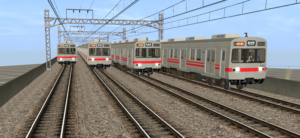Part of the Tokyu 8090 & 8590 Serieses pack

DOWNLOAD
As with the Tokyu 1000 Series pack, all the dependencies are either included in this pack or are avaible on the DLS, except for the pantographs wich must be downloaded from Rizky’s website (they’re included in the freeware EMU packs).
A groundbreaking train…
The Tokyu 8090 Series was designed in the mid-1970s to be a testbed for new rolling stock manufacturing tecniques. It’s main fetaure was it’s use of a lightweight stainless-steel body developed by Tokyu Car Co. (nowdays J-TREC, it was a rolling stock manufacturer formerly owned by Tokyu Railway itself) using a computerized mathematical analysis program to calculate strain and fatigue, derived from those used in aircraft design, wich resoulted in a bodyshell about 24% lighter (a weight reduction of 2 tons per car or about 8% for a whole train) than conventional stainless-steel ones (such as those used on Tokyu’s 8000 and 8500 Series trains).
This actually made the 8090 Series one of the world’s first trains desinged with the help of computers, and this type of lightweight stainless steel bodyshell was subsequently used on many other trains, peaking in 1985, when it was selected by JNR (with a few modifications) to be the bodyshell of what was to be it’s “savior commuter train”: the 205 Series.
Back to Tokyu, two prototype intermediate motor cars (DeHa 8401 and 8402) were manufactured in 1978. Inserted into a 8000 Series formation, they entered service on the Toyoko Line in the same year, and in 1980, the production of the new trains was started.
Originally intended to be classified as “9000 Series”, they were later renumbered as the “8090 Series”, making them part of the large 8000 Series family.
It might seem odd as they look completely different, but besides the bodyshell, the 8090 Series is actually very close to the 8000 Series, in fact they use the same bogeys, motors, pantographs, shunt-chopper traction control and other equipment, making them perfectly compatible (as said before, the two prototype motor cars were actually ran in a 8000 Series set).
The first 8090 Series trains entered service on the Toyoko Line on the 27th of December 1980, replacing the older 18m 3-door trains (5000, 5200 and 6000 Series), wich were displaced to the Oimachi Line.
The first three production sets had lower headlights, but from the fourth onward, the headights were placed at a more conventional middle-height. Eventually, all the older stock was displaced from the Toyoko Line by the mid 1980s.
